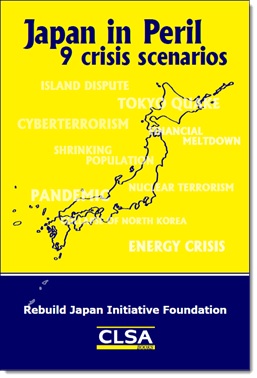
Author: Rebuild Japan Initiative Foundation
Publisher: CLSA
Paperback: 199 pages
First Published: February 20, 2014
ISBN: 978-988-98942-6-9
Reports in other languages
Japanese:
『日本最悪のシナリオ 9つの死角』
Author: Rebuild Japan Initiative Foundation
Publisher: Shinchosha
First Published: March 15, 2013
ISBN: 978-4103337317
Korean:
일본 최악의 시나리오 9개의 사각지대
(Japan in Peril? : 9 crisis scenarios)

Author: 일본 재건 이니셔티브(Rebuild Japan Initiative Foundation)
Publisher: NANAM Publishing House
First Published: February 26, 2015
Language: Korean
ISBN: 978-89-300-8746-9
Preface
Part 1: Disaster Scenarios
1. Island dispute: Confrontation over Senkaku
2. Financial meltdown: Japan suffers boiling-frog syndrome
3. Tokyo quake: Collapse of amazon.com society
4. Cyberterrorism: Urban infrastructure under attack
5. Pandemic: The day the doctors disappeared
6. Energy crisis: Strait of Hormuz blocked
7. Collapse of North Korea: Japan’s non-nuclear principles waver
8. Nuclear terrorism: Did we learn anything from 3/11?
9. Shrinking population: Japan’s youth turn into terrorists
Part2: What the Scenarios Tell Us
10. Legal framework
11. Coordination between state and private sector for managing risks
12. Cross-border strategies
13. Role of the Prime Minister’s office
14. Communication
The 9 worst case scenarios
-
Senkaku incident: the unexpected denouement of defensive and offensive posturings over the islands
In response to China’s increasing menace over the Senkaku islands, Japan must prepare for a battle entailing a collective effort; it will require not only military force, but also efforts in the spheres of diplomacy, politics, economics, and information transmission. Once the smoke has cleared, the outcome will dramatically alter the prevailing order and power dynamics of East Asia.
-
Japanese government bond market plunge: the “boiled frog” risk facing Japan
Japanese government debt has soared to more than 200% of GDP. At just 10%, consumption tax is a mere drop in the bucket. Nevertheless, owing to the competitiveness of the manufacturing industry and the sheer enormity of the economy, a southern European-type collapse can be avoided. But what waits in the aftermath…?
-
Tokyo Metropolitan Megaquake: collapse of an Amazon-type society
The probability of an earthquake directly hitting Tokyo within the next 30 years surpasses 70% in some areas of the city. Preventive measures are being taken based on the lessons of the Great Hanshin-Awaji Earthquake and the Great East Japan Earthquake. However, the idea is merely a “convenient scenario”. Preparations thus do not assume the worst, and the demonstrable effectiveness of the measures is therefore questionable.
-
Cyberterrorism: targeting urban infrastructure
Apparently, some countries – including Israel, North Korea, and China – are amassing hackers to form a covert cyber-attack force. A new war targeting the modern lifeline, threatening to paralyze critical infrastructures, has thus begun.
-
Pandemic: the day the doctors disappeared
In the midst of a raging unknown virus outbreak, the medical field will face the crisis of an impending collapse through lack of adequate medical staff and equipment. Solving the problem will hinge on whether difficult decisions can be made about who should die first.
-
Energy crisis: an invisible chain of crises beginning from a blockade of the Strait of Hormuz
Forty years have passed since the oil crisis stemming from the 1973 Yom Kippur War. Although there has not been much cry for a review of Japan’s energy strategy, there is a growing dependence on the Middle East. The ongoing state of affairs is such that a disturbance in the Straits could lead to a nationwide standstill for Japan.
-
Collapse of North Korea: the three anti-nuclear principles, Japan’s moment of decision
In the wake of the unification of North and South, the rising nationalism radiating out from the Korean Peninsula will spread through East Asia in a domino effect. The forbidden scenario of a nuclear-armed Japan will become a real possibility, and regional dynamics will immediately destabilize.
-
Nuclear terrorism: lessons from 3/11
Nuclear bombs have directly hit Kasumigaseki and Nagatacho, the two main administrative centers of Japan, and key government officials including the Prime Minister are all dead. How are the remaining survivors meant to proceed at that moment? The focus should be on training in earnest for the worst conceivable scenario, but…
-
Weakened population: 2050, the day youths become terrorists
Gradually but surely, the shrinking population will undermine Japan. Unless prompt action is taken, despair will sweep Japanese society in just a few short decades. However, to avert such a scenario, we must be prepared to relinquish the traditional Japanese views on society, family, and marriage.
 APIニュースレター 登録
APIニュースレター 登録
